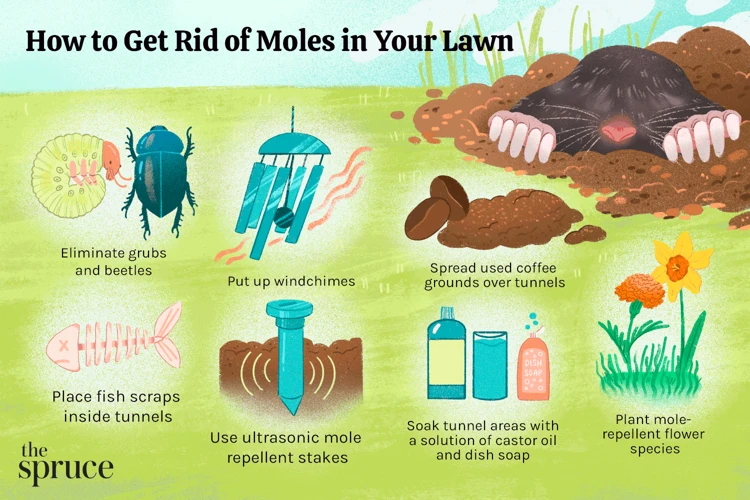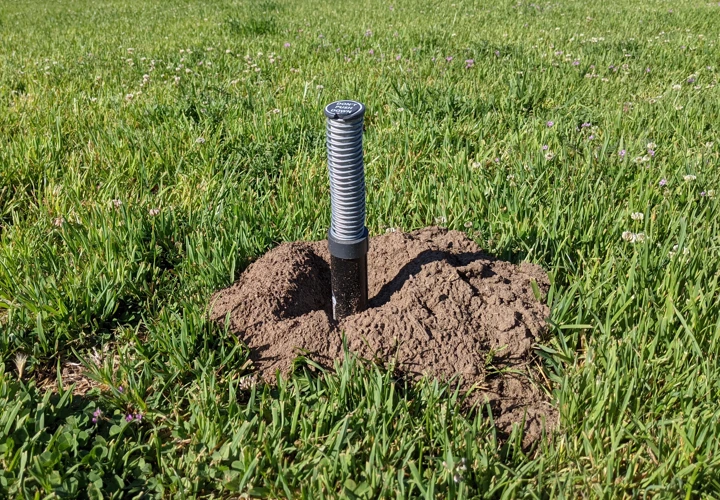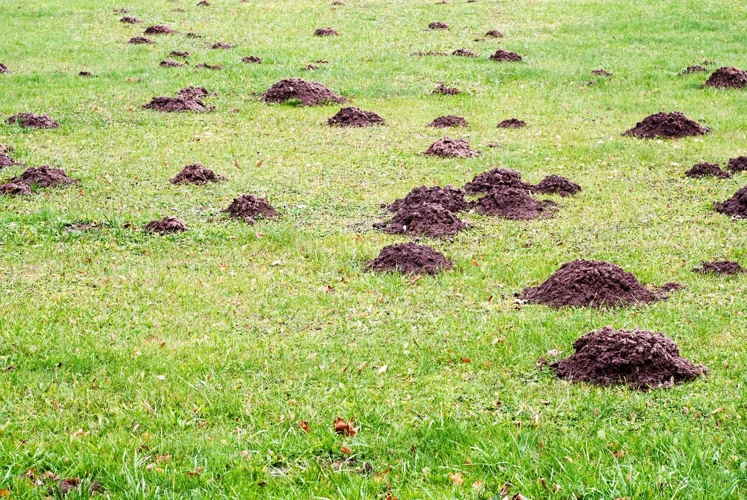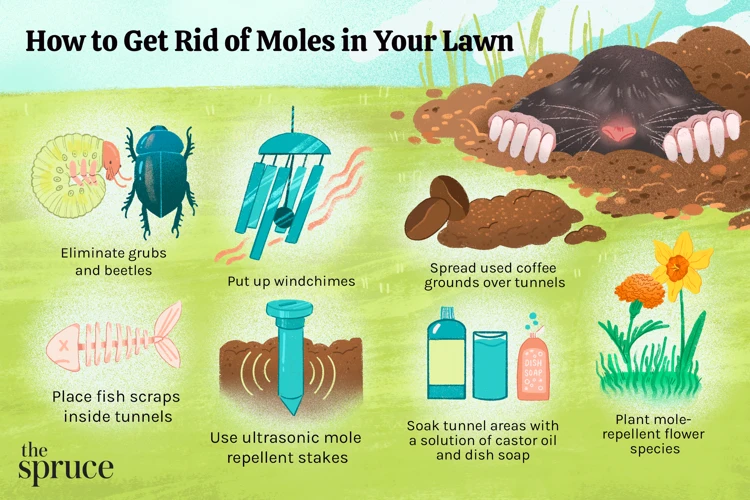Introduction

Maintaining a beautiful lawn can be a challenging task, especially when moles decide to make their home in your yard. These pesky creatures can cause extensive damage to your turf, flower beds, and even your trees. It’s essential to identify and prevent mole damage before it becomes a bigger issue. In this article, we’ll provide you with expert tips on how to identify mole damage and provide prevention methods to keep your lawn looking its best. Additionally, we’ll discuss ways to set mole traps and safely remove these critters if they’ve already taken over your yard.
Why You Need to Prevent Mole Damage
Preventing mole damage to your lawn and garden is crucial as moles can cause significant problems to the root systems of your plants and grass, and can damage underground utilities. Mole damage can lead to unsightly mounds and tunnels, making it difficult to maintain a beautiful lawn. Identifying mole damage early on is key to preventing further damage. Mole damage can often be confused with damage caused by other pests, and it is important to learn how to distinguish between different types of lawn pests to properly address the issue. Once you have identified the damage as caused by moles, you can start implementing prevention techniques to keep them at bay. These include choosing the right plants for your lawn, eliminating grubs and insects, installing barriers, and using natural repellents. If left unchecked, mole damage can quickly spiral out of control and impact the overall health of your lawn and its appearance. It is important to take preventative measures before the issue becomes too severe.
Identify the mole damage

One of the most important steps in preventing mole damage in your lawn or garden is being able to identify it. Moles can cause extensive damage to plant roots and create unsightly mounds and tunnels in the lawn. It’s important to understand the signs of mole damage so that you can take appropriate action. To learn more about identifying mole damage and the different types of damage it can cause, visit /mole-damage-vs-other-pests-lawn/.
Find the mounds and tunnels
One of the first steps in preventing mole damage is to identify the areas where moles have been active. Finding the mounds and tunnels created by moles is crucial in determining where to focus your preventative efforts. The mounds are typically circular and raised areas of soil, while the tunnels are visible as raised ridges in the soil.
Here are some tips for finding mole mounds and tunnels:
- Walk around the lawn and garden areas and closely inspect the soil for raised areas or ridges.
- Look for fresh soil that has been pushed up to the surface, which could indicate recent mole activity.
- Check along the edges of garden beds and plantings, as moles often like to tunnel along these areas.
- Use a broom handle or other long object to probe the soil and locate tunnels.
Identifying the areas where moles have been active is also important in determining the extent of the damage. In addition to mounds and tunnels, check for damage to plant roots. This can be seen as wilted or discolored foliage, or plants that are easily pulled up from the soil. For more information on identifying and repairing mole damage to plants, check out our article on mole damage to garden and flower beds.
Look for damage to plant roots
When moles burrow through the soil in search of food, they create tunnels that can damage the roots of plants in your lawn and garden. It’s important to keep an eye out for these tell-tale signs of mole damage to plant roots in order to prevent further destruction.
Signs of mole damage to plant roots:
| Damage | Appearance |
|---|---|
| Wilting leaves or stunted growth | The plant may appear weak and unhealthy |
| Yellowing leaves | The plant may have a nutrient deficiency due to the mole tunneling disrupting the soil |
| Broken or chewed roots | Visible damage to the roots when digging around the plant |
| Uprooted plants | Moles burrowing under the plant can cause it to become loose and uprooted |
If you notice any of these signs of mole damage to plant roots, it’s important to take action to prevent further damage. You can check if moles are the cause of this damage by inspecting your lawn for their mounds and tunnels. If you’re unsure how to identify these features, check out our article on mole burrow identification.
Preventing mole damage to plant roots requires a multifaceted approach, including choosing the right plants, keeping the lawn well-watered, eliminating grubs and insects, installing barriers, and using natural repellents. For more information on these prevention tips, check out the section on “Prevention Tips” in the article.
Prevention Tips

It’s no secret that moles can wreak havoc on a homeowner’s lawn. From unsightly mounds to damage to plant roots, mole damage can quickly become a headache. But fear not, there are several preventative measures you can take to keep your lawn in top shape. By choosing the right plants, eliminating grubs and insects, and using natural repellents, you can protect your lawn and keep those pesky moles at bay. Let’s dive into some tips for preventing mole damage.
Choose the right plants
Choosing the right plants can greatly impact the likelihood of mole damage to your lawn. Some plants are more attractive to moles than others, so it’s important to choose plants that are less likely to attract them. One way to deter moles is to plant plants with strong smells or tastes that moles don’t like. Here are some plant options:
- Daffodils: The smell of daffodils is unappealing to moles, making them a great choice for your garden.
- Alliums: The strong smell of alliums helps repel moles.
- Fritillarias: Similar to alliums, fritillarias have a strong smell that moles don’t like.
- Datura: This plant has a bitter taste that moles tend to avoid.
- Crown imperial: The smell of crown imperial has been known to repel moles.
Note: Keep in mind that planting these types of plants is not a foolproof way to prevent mole damage, but it can be a helpful addition to other prevention methods.
It’s also important to avoid planting anything close to underground utilities, such as gas lines or water pipes. Moles often enjoy digging around these areas and can cause significant damage to underground utilities. If you’re unsure of where your underground utilities are located, it’s best to contact a professional to ensure you don’t accidentally disrupt any lines while planting.
For more information on the effects of mole damage on plant roots, see our article on mole damage to plant roots.
By being selective in your plant choices and avoiding planting near underground utilities, you can reduce the likelihood of mole damage to your lawn and garden.
Keep the lawn well-watered
One great way to prevent mole damage is by keeping your lawn well-watered. Moles tend to be attracted to dry soil where insects are more easily found. By keeping your lawn hydrated, you’re creating a less desirable habitat for these pests.
To ensure you’re watering correctly, use a sprinkler system or hose to distribute water evenly throughout the lawn. Avoid over-watering as it can lead to other issues such as fungal growth and disease. An over-watered lawn can also cause plant roots to rot and die, which will encourage moles to move in and take over.
On the other hand, under-watering can also attract moles since it creates an environment where insects are forced closer to the surface in search of water, making them easier to find and catch for the mole.
It’s also important to remember that the time of day you water can be crucial. Watering in the early morning or evening can help reduce evaporation and save water while still keeping your lawn hydrated.
By consistently watering your lawn, you can help prevent damage caused by moles while also improving the overall health of your lawn. Remember to check for any underground utilities or wires before digging to avoid any potential accidents. If you’re unsure, contact a professional before starting any digging. For more information on how mole damage can affect your lawn’s health, read our article on mole damage and lawn health.
Eliminate grubs and insects
Eliminating grubs and insects can be an effective way to prevent mole damage in the long term. Moles feed on grubs and insects like Japanese beetles and grubs, which can damage the roots of your plants and lawn, making them more prone to mole presence. Here are some steps you can take to eliminate grubs and insects:
- Apply insecticides: Use insecticides, such as neem oil or pyrethrin, to kill grubs and insects before they have a chance to cause damage to your lawn. Be sure to follow the instructions carefully and use the appropriate protective gear when applying the insecticides.
- Natural remedies: You can also use natural remedies like nematodes, which are microscopic worms that feed on the larvae of some insects but do not harm other creatures. Milky spore disease is another natural remedy that could be used to get rid of grubs. It is a soil-borne bacterium that can be applied in the form of a powder or granule.
- Remove food and shelter sources: If you have areas in your lawn where there is standing water or damp soil, it can attract insects and grubs. Remove any debris like piles of leaves or grass clippings, as they can provide shelter for insects and other pests.
- Maintain Lawn: Keep your lawn healthy, by mowing it on a regular basis, and watering it properly. This will help the grass develop deeper roots and make it more resilient to damage caused by mole activities.
Remember, eliminating grubs and insects will not completely deter moles from your lawn, but it can help discourage them from making it their home. It is important to use a combination of techniques, including natural repellents, physical barriers, and traps to prevent and remove moles completely.
If you want to learn more about mole traps and removal, check out our article on Benefits and Drawbacks of Traps for Mole Removal. Or if you want to know how to repair your lawn from mole damage, check out our article on How to Repair Lawn Damage from Moles. Additionally, if you are worried about mole damage to your underground utilities, we have an article dedicated to that topic Mole Damage to Underground Utilities: Prevention and Repair.
Install barriers
One of the most effective ways to prevent moles from damaging your lawn is by installing barriers. Barriers make it difficult for moles to access your plants, lawn, and garden areas. They can be installed using various materials and techniques, including:
| Barrier | Description |
|---|---|
| Hardware cloth or mesh | This material is installed beneath the soil and around the plants. The mesh prevents moles from burrowing underground and reaching the plant roots. |
| Burying galvanized hardware cloth around garden beds | This technique entails burying galvanized hardware cloth about two feet deep around garden beds to prevent moles from burrowing under them. This method helps to keep moles out of your garden beds and protect your plants. |
| Perimeter fence | A barrier in the form of a perimeter fence can help prevent moles from accessing your lawn, particularly if it’s made of mesh material or buried hardware cloth. |
It’s important to note that barriers work best when combined with other prevention methods, such as eliminating grubs and insects or natural repellents. These barriers are particularly useful for long-term prevention, and they may require a bit of upfront investment, but the benefits are worth it. Keep in mind that when installing barriers, you should take care not to interfere or affect your home’s underground utilities. If unsure, seek expert help to avoid causing damage to your essential underground systems.
Use natural repellents
One effective way to prevent mole damage is by using natural repellents. These repellents work by emitting strong odors that moles can’t stand. Here are some natural repellents that you can use:
- Castor Oil – Castor oil is a natural repellent that can keep moles and other pests away from your lawn. You can mix castor oil with water and spray it on your lawn to create a barrier that moles won’t cross.
- Peppermint Oil – Peppermint oil has a strong scent that moles find unpleasant. You can mix peppermint oil with water and spray it on your lawn to create a deterrent that will keep moles away.
- Epsom Salt – Epsom salt is another natural repellent that can keep moles away from your lawn. You can sprinkle Epsom salt on your lawn and around your garden to create a barrier that moles won’t cross.
- Garlic – Garlic has a strong odor that moles will avoid. You can crush garlic cloves and spread them around your lawn and garden to create a barrier that moles won’t cross.
- Onion – Like garlic, onion has a strong odor that moles will avoid. You can chop up onions and spread them around your lawn and garden to create a deterrent that will keep moles away.
Using natural repellents is a safe and effective way to prevent mole damage. These repellents are easy to make and can be applied directly to your lawn and garden. Remember to reapply the repellent after rain or irrigation to ensure continued protection against mole damage.
Mole Traps and Removal
Dealing with a mole invasion can be frustrating, but there are effective methods to remove them from your lawn. If you’ve tried every prevention tip and still have mole damage, it’s time to utilize mole traps and removal techniques. With a bit of patience and skill, you can use humane traps or choose to hire a professional to remove the pesky creatures. Keep reading to learn how to effectively set mole traps and safely remove moles from your yard.
Set mole traps
When it comes to controlling mole populations, traps are often the most effective method. Here are some tips for setting mole traps:
| Step 1: | Locate active mole tunnels by flattening them down and checking to see which tunnels are reopened within 24 to 48 hours. These are the best places to set traps. |
| Step 2: | Wear gloves to avoid leaving your scent on the trap. Moles have a strong sense of smell and may be wary if they detect human scent. |
| Step 3: | Follow the instructions carefully for the type of mole trap you are using, as there are several different designs on the market. |
| Step 4: | Place the trap in the mole’s active tunnel and position it correctly according to the instructions. Typically, you’ll want to set the trap so that the trigger is perpendicular to the tunnel, with the jaws facing out towards the mole’s direction of travel. |
| Step 5: | Be patient and leave the trap undisturbed for at least 24 to 48 hours before checking it. This gives the mole enough time to get used to the presence of the trap and let down its guard. |
Tip: If you’re unsure about trapping moles on your own or prefer not to handle live animals, consider hiring a professional pest control service to take care of the problem for you.
Safely remove moles
One of the ways to deal with mole damage is to safely remove these animals from your lawn. However, it’s important to do it without harming or killing them. Here are some safe methods you can use:
| Method | Description |
|---|---|
| Live Traps | You can use live traps to capture moles without causing them any harm. These traps are designed to keep the moles inside until you release them into a nearby wooded area or field. |
| Bucket Traps | Bucket traps are designed to trap moles and prevent them from escaping. You can create a bucket trap by digging a hole in the ground and placing a bucket in it. Cover the top of the bucket with a thin layer of soil and place a board on top of it. When the mole comes to investigate, it will step on the board and fall into the bucket. |
| Sealing Mole Tunnels | If you have identified the main mole tunnels, you can try sealing them with soil or other materials. This will prevent the moles from using these tunnels and force them to move to other areas. |
| Natural Predators | You can also use natural predators like cats, dogs, and owls to help control mole populations. These predators can be trained to sniff out and catch moles. |
Remember that it’s important to relocate moles to a safe location instead of harming or killing them. Use these safe methods to remove moles from your lawn and prevent further damage.
Conclusion
As we wrap up this article on mole damage prevention, it’s clear that these small underground creatures can cause big problems for homeowners. However, by implementing the preventative measures and mole removal techniques we’ve discussed, you can regain control of your lawn and protect it from further damage. Remember to stay vigilant and follow these tips to keep your yard looking beautiful all season long. Don’t let moles ruin your outdoor space – take action and keep your lawn lush and healthy!
Moles can easily take over a lawn and cause significant damage. Be proactive and use these prevention tips to keep your lawn looking its best all season long.
One of the biggest concerns for any homeowner with a lawn is the potential damage that can be caused by moles. These small creatures may seem harmless, but they can quickly take over a lawn and cause significant damage to both the grass and any plants in the vicinity. To prevent this from happening, it is important to take a proactive approach and implement some mole damage prevention tips.
Prevention tips:
To keep moles from damaging your lawn, it is important to follow these simple prevention tips:
1. Choose the right plants: Certain plants are more susceptible to mole damage than others. When choosing plants for your lawn, opt for those that are less likely to attract moles, such as daffodils or alliums.
2. Keep the lawn well-watered: Moles are attracted to dry, compacted soil, so it is important to keep your lawn well-watered to prevent it from drying out.
3. Eliminate grubs and insects: Moles often feed on grubs and other insects, so eliminating these pests can help keep moles from being attracted to your lawn in the first place.
4. Install barriers: Installing barriers around your garden or lawn can also help keep moles at bay. This can include wire mesh or large rocks.
5. Use natural repellents: Certain natural substances, such as castor oil or cayenne pepper, can be effective in repelling moles. Consider using these natural repellents around your lawn or garden to keep moles away.
Using these prevention tips can help you keep your lawn looking its best all season long, while also keeping moles from causing damage to your plants and grass.
Frequently Asked Questions
How do moles damage lawns?
Moles create tunnels and mounds when searching for food, which can damage the roots of plants and cause unsightly bumps in the lawn.
Can moles be harmful to humans?
Moles are not harmful to humans and do not carry any diseases.
What are some signs that moles are present in a lawn?
Mounds of soil, raised ridges on the lawn, and damaged plant roots are all signs that moles may be present.
What plants do moles like to eat?
Moles do not eat plants, but they do disrupt the roots of plants while searching for grubs and insects to eat.
What is the best way to remove moles from a lawn?
The most effective way to remove moles is by setting traps that will capture them humanely.
Is it possible to prevent mole damage?
Yes, there are several prevention tips that homeowners can follow to reduce the risk of mole damage to their lawns.
What types of barriers can be installed to prevent mole damage?
Metal mesh or landscaping fabric can be installed below the surface of the soil to prevent moles from burrowing into the lawn.
What are some natural repellents that can be used to prevent moles?
Caster oil or a mixture of garlic and chili powder can be spread over the lawn to repel moles.
How often do moles reproduce?
Moles reproduce once a year, typically in the springtime.
Why is it important to address mole damage promptly?
Mole damage can lead to further lawn problems and can be expensive to repair if left unchecked. Addressing the issue promptly can prevent more extensive damage down the line.







